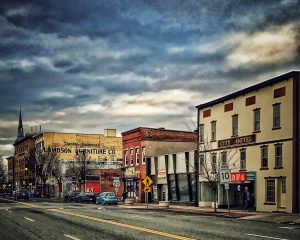
Elm Street captured by photographer Danny Nason, 2017.
WESTFIELD – On Thursday, the Baker-Polito administration announced its selection of the 138 low-income census tracks in Massachusetts submitted as “Opportunity Zones” to the U.S. Treasury Department to encourage long-term investment in eligible Massachusetts communities. Created as part of the federal Tax Cuts and Jobs Act of 2017, the Opportunity Zone program presents an opportunity for private, tax-free investment into areas of economic need, benefiting both residents living in the zones and private investors.
City Advancement officer Joseph Mitchell said Westfield had two tracts up for consideration; the one that was chosen was the downtown Elm Street corridor.
“It’s an investment opportunity that encourages people to invest in census tracts in low to moderate income neighborhoods, like Elm Street downtown,” Mitchell said in speaking about the grant potential earlier this month.
The Opportunity Zone program provides a federal tax incentive for taxpayers who reinvest unrealized capital gains into ‘Opportunity Funds,’ which are specialized vehicles dedicated to investing in low-income areas called ‘Opportunity Zones.’ The zones themselves are comprised of low-income community census tracts and designated by governors in every state.
In the award letter, Jay Ash, Secretary of the Executive Office of Housing and Economic Development (EOHED), said applications were evaluated based on the opportunities for economic development, the planning and preparation work communities have undertaken, and the demographics of both the census tract and the larger community.
“Here in Massachusetts, our communities have proven that planning, site readiness, and community engagement are major factors in successful development. The tracts identified by the nominating communities reflect these characteristics and are worthy of consideration by the federal government,” Ash said.
“We are very happy to have our downtown designated as an Opportunity Zone. It will allow for unique investment possibility for developers and investors in Westfield. It will help our community stand out when compared to some of the surrounding cities and towns and we look forward to what the future holds,” said Mayor Brian P. Sullivan about the designation.
The Commonwealth’s only formal role in the Opportunity Zone Program is to designate census tracts as opportunity zones. Governors were allowed to designate a number of census tracts equal to 25% of the low income community tracts in their state. Massachusetts had 547, and designated 138. The U.S. Treasury has committed to responding to state submissions within 30 days.
While the designation is an incentive for investors, it does not guarantee investment or government financial support. However, Ash said the EOHED would continue to work with communities to highlight opportunities.
“I do want to reiterate that this designation does not include any guaranteed investment or government financial support. EOHED hopes to continue working with your community to highlight opportunities and to facilitate your development efforts as best we can. However, we anticipate that any direct investments through this initiative will follow community support and private sector interest,” Ash wrote.
“The investment advantages associated with the Opportunity Zone designation can assist in development for the City, Westfield Redevelopment Authority and private property owners. It is another tool to finance projects like the WRA’s Urban Renewal project or renovation of the Bentley Billiards building,” Mitchell said.
Other municipalities in Western Mass with state-designated Opportunity Zone tracts submitted for federal approval include Agawam, Amherst, Chicopee, Easthampton, Greenfield, Holyoke, Ludlow, North Adams, Northampton, Palmer, Pittsfield, South Hadley, Springfield, West Springfield, and Ware.








